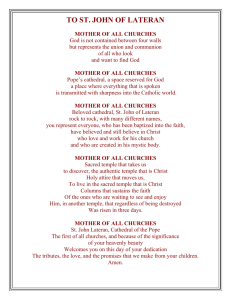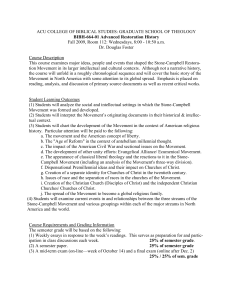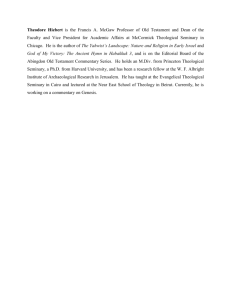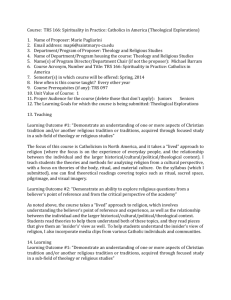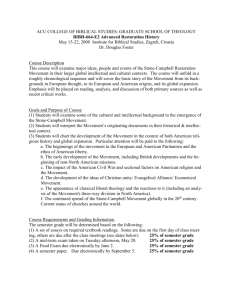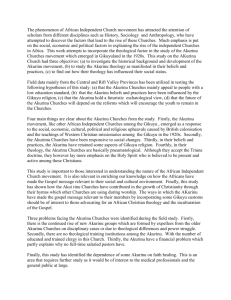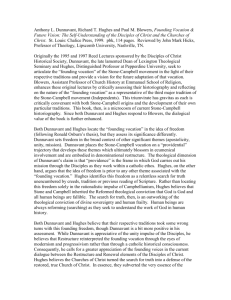The Encyclopedia of the Stone
advertisement
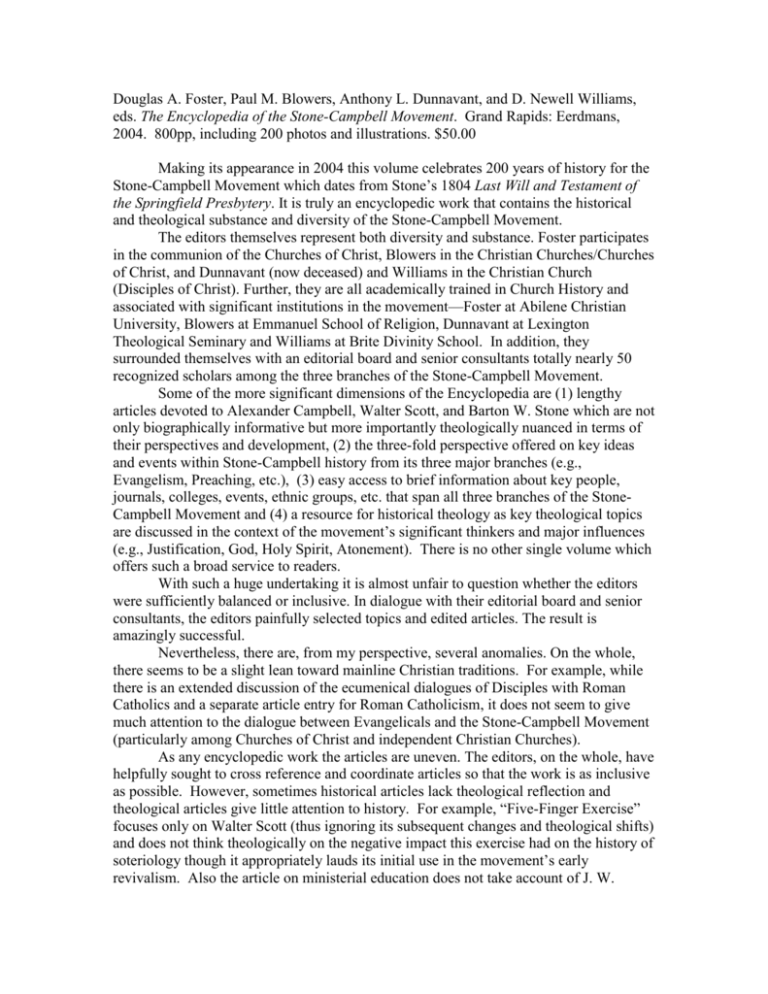
Douglas A. Foster, Paul M. Blowers, Anthony L. Dunnavant, and D. Newell Williams, eds. The Encyclopedia of the Stone-Campbell Movement. Grand Rapids: Eerdmans, 2004. 800pp, including 200 photos and illustrations. $50.00 Making its appearance in 2004 this volume celebrates 200 years of history for the Stone-Campbell Movement which dates from Stone’s 1804 Last Will and Testament of the Springfield Presbytery. It is truly an encyclopedic work that contains the historical and theological substance and diversity of the Stone-Campbell Movement. The editors themselves represent both diversity and substance. Foster participates in the communion of the Churches of Christ, Blowers in the Christian Churches/Churches of Christ, and Dunnavant (now deceased) and Williams in the Christian Church (Disciples of Christ). Further, they are all academically trained in Church History and associated with significant institutions in the movement—Foster at Abilene Christian University, Blowers at Emmanuel School of Religion, Dunnavant at Lexington Theological Seminary and Williams at Brite Divinity School. In addition, they surrounded themselves with an editorial board and senior consultants totally nearly 50 recognized scholars among the three branches of the Stone-Campbell Movement. Some of the more significant dimensions of the Encyclopedia are (1) lengthy articles devoted to Alexander Campbell, Walter Scott, and Barton W. Stone which are not only biographically informative but more importantly theologically nuanced in terms of their perspectives and development, (2) the three-fold perspective offered on key ideas and events within Stone-Campbell history from its three major branches (e.g., Evangelism, Preaching, etc.), (3) easy access to brief information about key people, journals, colleges, events, ethnic groups, etc. that span all three branches of the StoneCampbell Movement and (4) a resource for historical theology as key theological topics are discussed in the context of the movement’s significant thinkers and major influences (e.g., Justification, God, Holy Spirit, Atonement). There is no other single volume which offers such a broad service to readers. With such a huge undertaking it is almost unfair to question whether the editors were sufficiently balanced or inclusive. In dialogue with their editorial board and senior consultants, the editors painfully selected topics and edited articles. The result is amazingly successful. Nevertheless, there are, from my perspective, several anomalies. On the whole, there seems to be a slight lean toward mainline Christian traditions. For example, while there is an extended discussion of the ecumenical dialogues of Disciples with Roman Catholics and a separate article entry for Roman Catholicism, it does not seem to give much attention to the dialogue between Evangelicals and the Stone-Campbell Movement (particularly among Churches of Christ and independent Christian Churches). As any encyclopedic work the articles are uneven. The editors, on the whole, have helpfully sought to cross reference and coordinate articles so that the work is as inclusive as possible. However, sometimes historical articles lack theological reflection and theological articles give little attention to history. For example, “Five-Finger Exercise” focuses only on Walter Scott (thus ignoring its subsequent changes and theological shifts) and does not think theologically on the negative impact this exercise had on the history of soteriology though it appropriately lauds its initial use in the movement’s early revivalism. Also the article on ministerial education does not take account of J. W. McGarvey’s magisterial piece in Lard’s Quarterly where he provides the theological and practical ground for seminary education beyond the liberal arts degree. Other articles focus too narrowly on specific leaders and are not sufficiently inclusive. For example, the article on prayer summarizes Campbell, Stone and Richardson, but this is hardly representative of prayer in the Stone-Campbell Movement. Sitting next to the substantive article on preaching, the contrast is chilling if one thinks that this is reflective of our heritage’s emphases or its possible lack of spirituality. The article “Bible College Movement” does not take sufficient account of Churches of Christ—especially its rather different conception of “Bible College” (as per James A. Harding) as well as the contemporary participation in the AABC by some colleges among Churches of Christ (e.g., Magnolia Bible College). Also one could always critique the amount of space that is given to one person versus that given to another. For example, Richard McNemar seems to be given an inordinate amount of space when David Lipscomb receives a similar amount and James A. Harding very little. Some choices seem rather remote or historically peripheral while other more substantial persons are unacknowledged. For example, Joseph Hostetler and Benjamin Lynn certainly had influence, but it does not seem to compare substantially with the influence J. M. Barnes had in Alabama Churches of Christ in the late 19th and early 20th century (graduate of Bethany, planter of churches, defender of conservative perspectives and founder of Highland Home College, which was as important to Alabama as was Franklin College to Tennessee but does not receive space). While Leroy Garrett’s Restoration Review has a separate entry Carl Ketcherside’s Mission Messenger does not. “Open Forum” means something quite different and more influential among Churches of Christ than the seemingly marginal events discussed in the article under that title. Even in terms of significant opponents of the Stone-Campbell while Jeter is rightfully included, Andrew Broaddus does not have a separate entry. In the theological articles there is a tendency, which I notice in myself as well (see my Atonement article), to emphasize the 19th century over the 20th century. This is perhaps a matter of perspective (distance gives us more), research (tools are available) and interest, and it varies from writer to writer. Yet, there is a healthy emphasis on historical theology as well as biographies, institutions, etc. These articles are usually very helpful and illuminating (e.g., articles on God and Eschatology). But there are some dimensions of theology lacking (e.g., election or predestination?) though perhaps this is more reflective our heritage’s lack of constructive engagement with those theological ideas rather than anything else. But all of this is basically nit-picking and indeed reflective of my own proclivities and interests. Without doubt this work has no equal, no peer and no pretender. It stands alone as the single most valuable resource available for historians and theologians of the Stone-Campbell Movement. Even if all my “nit-picking” was included it would not substantially improve this volume since it already presents itself as a definitive and unparalled resource. While everyone might be disappointed that “this or that” was not included or disagree with some interpretative judgments, none should be disappointed with the product as a whole. Every minister within and every serious student of the StoneCampbell Movement should digest this work. Its multiple perspectives, serious interpretations, theological history and historical identification of key people, events, and institutions are invaluable to those who want to understand two hundred years of StoneCampbell history and theology. As the contribution of hundreds of minds and the result of competent editing, it is already the standard in the field. John Mark Hicks Professor of Theology Lipscomb University



